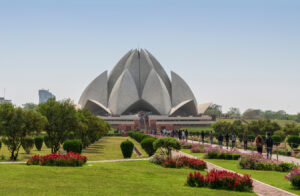Top Historical Sites in Delhi: A Journey Through Time
Overview of Top Historical Sites
India’s capital city, Delhi, Top Historical Sites is a dynamic fusion of the past, present, and future. Being among the world’s oldest cities, it provides a rare chance to discover the ruins of its illustrious past. Delhi is dotted with historical sites that tell the tale of empires, rulers, and the development of civilization, from ancient ruins to imposing monuments. Let’s take a trip back in time to explore the most important historical locations that Delhi has to offer history buffs.

1. Overview of Red Fort (Lal Qila)
The Red Fort, built by the Mughal Emperor Shah Jahan in the 17th century, is a famous representation of India’s lengthy history and a UNESCO World Heritage Site. It is a breathtaking sight with its enormous red sandstone walls and elaborate architecture.
Principal Draws
Diwan-i-Aam: The Public Audience Hall, where the emperor gave speeches to the general populace.
Diwan-i-Khas: The Hall of Private Audience, renowned for the peacock throne and its exquisite marble work.
2. Overview of Humayun’s Tomb
Another UNESCO World Heritage Site and a shining example of Mughal architecture is Humayun’s Tomb. Empress Bega Begum, the wife of Humayun, commissioned its construction in the sixteenth century.
Principal Draws
Charbagh Garden: The exquisite design of this Mughal garden, which represents heaven.
Tomb of Isa Khan: Located within the complex, this tomb is less well-known but just as beautiful.
Overview of Qutub Minar #3.
Qutub Minar, a UNESCO World Heritage Site, is the world’s tallest brick minaret, standing at 73 meters. It was constructed in the twelfth century and exhibits the Delhi Sultanate’s masterful architecture.
Principal Draws
Iron Pillar: A historic iron pillar distinguished by its anti-rust construction.
Quwwat-ul-Islam Mosque: Featuring elaborate architecture and carvings, this mosque was the first to be constructed in India.
4. Overview of India Gate
India Gate is a memorial to the soldiers who lost their lives in the Third Anglo-Afghan War and World War I. It serves as a reminder of sacrifice and pride in the country.
Principal Draws
Amar Jawan Jyoti: The soldiers’ eternal flame of honor.
Encircling Gardens: Ideal for a family picnic and a leisurely stroll.
5. Summary of Jama Masjid
Shah Jahan ordered Jama Masjid, one of the biggest mosques in India, to be built in the seventeenth century. Being a major religious site, it can accommodate over 25,000 worshippers and has beautiful architecture.
Principal Draws
Climbing the minarets provides a broad perspective of the thriving old city.
Courtyard: An expansive open area that adds to the mosque’s majesty.
6. Overview of Akshardham Temple
The Akshardham Temple is a modern architectural masterpiece, despite being relatively new. It was inaugurated in 2005 and symbolizes India’s cultural legacy.
Principal Draws
The Main Shrine is devoted to Bhagwan Swaminarayan and is finely carved.
Yagnapurush Kund: Boasting stunning gardens and landscapes, this stepwell is the biggest in the world.
7. Overview of Safdarjung’s Tomb
Safdarjung’s Tomb, which was constructed in the 18th century, is a superb illustration of Mughal architecture. Safdarjung was an aristocrat in the Mughal court, and this is his tomb.
Principal Draws
Mausoleum: Extensive gardens and water features encircle the main tomb.
Baradari: A lovely pavilion with a tranquil ambiance.
8. Overview of Tughlaqabad Fort
Constructed in the fourteenth century, Tughlaqabad Fort demonstrates the power of the Tughlaq dynasty. Despite being in ruins today, its enormous walls and buildings still bear witness to its illustrious past.
Principal Draws
Main Gate: The imposing entrance is a sight to behold.
Ruins and Viewpoints: The fort’s exploration offers breathtaking vistas of the surroundings.
Raj Ghat Overview, 9.
The memorial to Mahatma Gandhi, the father of the country, is located at Raj Ghat. It is a straightforward but profound homage to his teachings and life.
Principal Draws
Black Marble Platform: The memorial has lush gardens and a never-ending flame.
Information about Visitors: A calm place to think and study the legacy of Gandhi.
10. Overview of the Lotus Temple
One of the most beautiful Bahá’í Houses of Worship is the Lotus Temple, which is built in the shape of a lotus. It is a distinctive addition to Delhi’s historical landscape because it fosters peace and unity.
Principal Draws
A calm area for introspection and meditation is called a meditation hall.
Gardens: The temple is surrounded by exquisitely designed gardens that add to its calm ambiance.
In summary
In Delhi, there is a tale to be told around every corner. Its historical sites offer a window into the splendor of bygone times as well as the development of architecture and culture. Every location contributes to the mosaic of India’s rich past, whether you’re exploring the majestic buildings of New Delhi or meandering through the antiquated lanes of Old Delhi. So prepare for a trip through time as you pack your bags and head into the heart of India!
FAQ 1. When is the ideal time to visit Delhi’s historical sites?
The ideal months to go sightseeing are October through March, when the weather is nice.
2. Do these historical sites charge admission?
Yes, most sites charge an admission fee that varies according to the site. On certain days, some might offer free admission.
3. How can I get from one of these places to another?
For easy transportation, you can use rideshare apps, the metro, or a taxi.
4. Is it safe to tour Delhi’s historical sites?
Yes, it is generally safe, but at night, stay in well-lit areas and exercise constant caution with your belongings.
5. Are these locations photogenic?
Most places permit photography, but make sure to confirm with individual locations about any restrictions.
